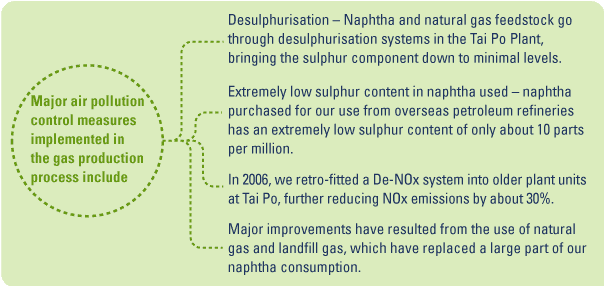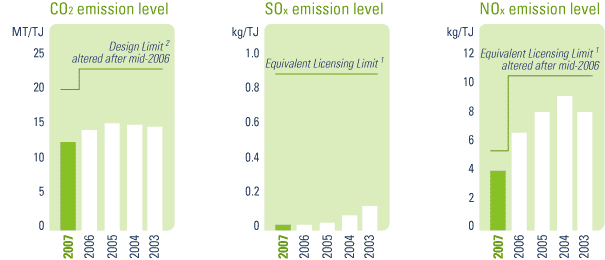| The Clean Air Charter’s Commitments |
| 1. | Operate to recognised world class standards, or standards established by the Hong Kong / Guangdong governments on the emission of air pollutants, even if it is not a requirements to do so at the current moment. |
| Progress | We have been meeting ISO 14001 Environmental Management System (EMS) standard at our Tai Po Plant since 1999. EMS provides a comprehensive framework for the management of environmental issues in a systematic manner whilst also providing the momentum to drive continuing improvement. Locally, emissions resulting from the production of town gas are stringently controlled under the Air Pollution Control Ordinance. We are pleased to report that we achieved full compliance with all relevant environmental legislation in 2007. |
| |
| 2. | Use continuous emission monitors (CEMs) at significant sources, eg large and medium plants. |
| Progress | NOx analyzers are installed on all gas production units at our Tai Po plant, continuously measuring the concentration of NOx in the flue gas of key plant. |
| |
| 3. | Publish information on energy and fuel use, as well as the total emission of air pollutants if emissions are significant, annually and in a timely manner. |
| Progress | The information is published in our sustainability report and corporate information booklet on an annual basis. |
| |
| 4. | Undertake the adoption of energy-efficient measures in their operations. |
| Progress | Major energy-efficient measures adopted in our gas production and head office operations are presented in the Electricity and Water Conservation section. Information on the management of our vehicle fleet is published in our “Employee Driving Handbook”, which provides guidance on eco-driving, car pooling and “switching off the engine” while idling, to conserve energy and reduce emissions. We also encouraged our dealers and contractors, who received our “Stop Idling Engine” stickers, to adopt the same eco-driving practices. |
| |
| 5. | Identify and encourage business-relevant measures to be used on days when air pollution is high. |
| Progress | We recognise the importance of trying to reduce emissions on days when air pollution is particularly high, while at the same time maintaining continuous gas supply. We have therefore identified work which generates air emissions but is not time critical to the provision of continuous gas supplies. These include the testing of emergency diesel-engine driven pumps and generators as well as welding work for non-urgent plant repairs. This type of work is now re-scheduled on days suffering high air pollution to minimise emissions as far as practicable. |
| |
| 6. | Share air quality expertise in business with others. |
| Progress | We regularly organise and attend events such as seminars and workshops which serve as excellent experience sharing platforms both for ourselves and our stakeholders. |




























